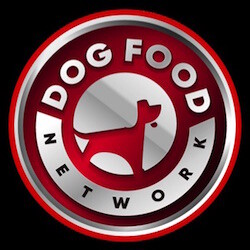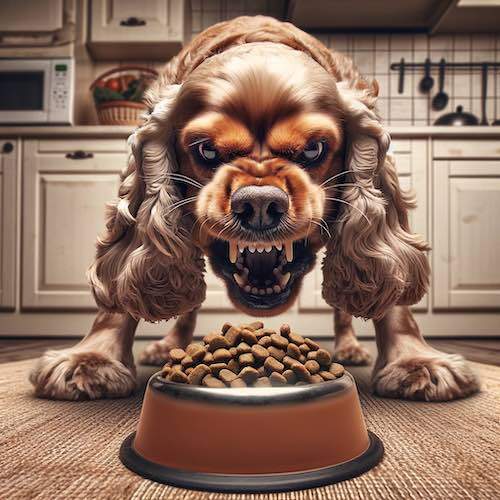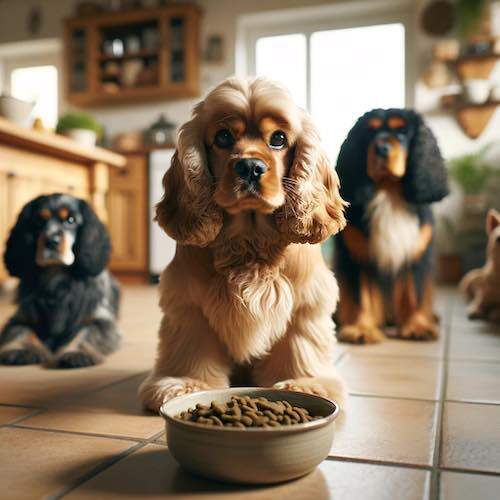Cocker Spaniel Food Aggression: Understanding the Causes, Recognizing the Signs, and Implementing Effective Training Strategies
Introduction
Cocker Spaniels, with their soulful eyes, floppy ears, and merry tails, capture the hearts of their families, embodying affection and loyalty. Known for their gentle nature and endearing personalities, they seamlessly integrate into family life, often forming deep, emotional bonds with their owners. However, beneath their amiable exterior, Cocker Spaniels, like any dog breed, can exhibit complex behaviors, including food aggression. This behavior, a form of resource guarding, arises from a mix of instinctual and environmental factors, requiring early identification and thoughtful intervention to maintain harmony within the home.
Food aggression in Cocker Spaniels is characterized by growling, snapping, or assuming a protective stance over their meals. This behavior is rooted in a primal instinct to defend valuable resources, a trait deeply embedded in their genetic makeup. Recognizing these signs early is paramount for effective and timely management.
Search: Best Selling Cocker Spaniel Products
Addressing food aggression in Cocker Spaniels demands patience, consistency, and a positive reinforcement approach. Strategies such as desensitization, counter-conditioning, and teaching impulse control commands like “leave it” or “wait” prove beneficial in mitigating this issue. Owners should approach this challenge with understanding, focusing on building trust and positive associations, rather than resorting to punishment. For individualized guidance, consulting with a certified dog trainer or a veterinary behaviorist is advisable to tailor a training program suited to the dog’s needs, ensuring safety for everyone involved.
Causes of Food Aggression in Cocker Spaniels
Understanding the roots of food aggression in Cocker Spaniels is crucial for addressing and mitigating this challenging behavior effectively. This behavior spectrum, which ranges from mild warning cues like growling to severe aggression such as snapping or biting, often reflects deeper insecurities, health issues, or learned responses. Several factors contribute to the development of food aggression in Cocker Spaniels:
- Early Life Experiences: Puppies competing over food or experiencing food scarcity during critical growth stages may develop a heightened guarding instinct. These early lessons in resource scarcity can profoundly influence their behavior around food.
- Survival Instinct: Despite their domesticated status, Cocker Spaniels retain an ancestral urge to secure essential survival resources. This instinct can manifest as food aggression, even in well-provided environments.
- Medical Conditions: Health issues can heighten food aggression tendencies. Pain, discomfort, or dietary deficiencies can render a Cocker Spaniel more irritable and prone to guarding their food more aggressively, often as an expression of their discomfort.
- Anxiety and Fear: Stress, anxiety, or fear, especially in unpredictable or threatening environments, may lead to increased resource guarding. This behavior can serve as a mechanism to control their environment and secure access to vital resources.
- Unintentional Reinforcement: Owner or pet reactions to a Cocker Spaniel’s aggressive guarding may inadvertently reinforce the behavior. If they learn that aggressive behaviors effectively deter others from their food, they’re likely to repeat these actions, reinforcing food aggression over time as a successful resource protection strategy.
Preventing Food Aggression in Cocker Spaniels Through Early Socialization
Laying a foundation of trust and positive experiences early on is essential in preventing food aggression in Cocker Spaniels. Establishing a secure and positive relationship with food and feeding practices can significantly shape a puppy’s attitude and behavior towards eating with humans and other pets. Essential strategies include:
- Communal Dining: Using separate bowls to feed puppies in proximity teaches them the concept of communal meals without the need for competition, fostering a sense of security.
- Building Trust with Interaction: Integrating hand-feeding practices and mixing treats into regular meals can strengthen the bond between puppies and their caregivers, associating human hands with positivity.
- Acclimating to Human Presence: Slowly introducing human proximity during meal times, paired with positive interactions, helps reduce any perceived threats, promoting a relaxed eating experience.
- Varied Feeding Experiences: Introducing diverse stimuli during meals, such as different settings and sounds, prepares puppies for various dining contexts, aiding in their ability to stay calm in any situation.
- Patience Training: Teaching puppies to wait for their food until given a cue not only instills patience but also enhances impulse control, decreasing the likelihood of aggressive reactions.
- Expanding Social Experiences: Broadening social experiences beyond meal times to include a variety of environments ensures puppies grow into well-adjusted adults, comfortable in numerous settings.
- Positive Reinforcement: Consistently rewarding calm, non-aggressive behavior around food reinforces these desired actions, encouraging continued positive behavior.
Recognizing Early Signs of Food Aggression in Cocker Spaniels
Timely identification of food aggression signs is pivotal for initiating early intervention strategies, which can prevent the escalation of aggressive behaviors. Recognizing these signs involves a keen observation of the Cocker Spaniel’s body language, vocalizations, and actions around food and feeding times.
- Subtle Changes in Body Language: Apart from stiffness, watch for subtle signs like the ears pulling back, the tail tucking under, or the whites of their eyes showing more prominently as they guard their food. These signs can precede more obvious aggression, indicating discomfort or a protective stance.
- Hovering or Circling: Before an intense gaze or protective positioning, some Cocker Spaniels may hover or circle around their food bowl, a behavior that suggests they feel the need to guard their meal even before they start eating.
- Vocal Warnings Variation: The variation in vocal warnings, from low murmurs to high-pitched whines, before escalating to growls or snarls, can indicate the level of discomfort or threat the dog feels. Recognizing these variations can help in understanding the intensity of the dog’s feelings.
- Guarding Other Items: Food aggression can sometimes extend to guarding other items such as toys, sleeping areas, or even people. Observing your Cocker Spaniel’s behavior around these resources can provide additional insights into their propensity for resource guarding.
- Changes in Eating Habits: Beyond rushed eating or concealment, there may be changes in their eating habits such as sudden loss of appetite or reluctance to eat unless alone. These changes can also signal stress or anxiety related to food.
Managing food aggression in Cocker Spaniels requires a multifaceted approach, prioritizing understanding and positive reinforcement over punitive measures. Enhanced strategies for effectively managing this behavior include:
- Structured Feeding Rituals: Beyond establishing a peaceful dining area, introducing structured rituals around feeding time can help. This might involve specific cues or actions before meals, helping to signal to your Cocker Spaniel that mealtime is a calm and structured event.
- Individualized Feeding Zones: For households with multiple pets, creating individualized feeding zones can prevent competitive behaviors and reduce stress for all animals involved, not just the Cocker Spaniel.
- Behavioral Adjustment Support: In addition to veterinary consultations, consider consulting with animal behaviorists who specialize in food aggression. They can offer targeted strategies and support adjustments in the dog’s environment to mitigate these behaviors.
- Incorporate Mental Stimulation: Alongside environmental enrichment, incorporating puzzle feeders or interactive toys during meal times can turn feeding into a brain-engaging activity, reducing the focus on guarding and enhancing the eating experience.
Advanced Training for Trust and Positive Associations
Building trust and positive associations through training is key to managing food aggression. Enhanced training methodologies include:
- Incremental Exposure: In desensitization, gradually increase the proximity of people to the dog while eating, starting from a distance where the dog is comfortable and slowly decreasing it over time, always within the dog’s comfort threshold.
- High-Value Reward System: In counter-conditioning, use high-value rewards that are more desirable than their regular food to create a strong positive association with the presence of people around their food bowl.
- Command Variation for Impulse Control: Expand beyond “leave it” or “wait” to include a variety of impulse control commands. Commands like “look at me” or “go to your spot” can provide alternative behaviors for your Cocker Spaniel to focus on, redirecting their attention from the food.
Practical Training Scenarios and Considerations
Implementing practical training scenarios requires careful planning and consideration:
Desensitization and Counter-Conditioning
Scenario: Begin with your dog in a calm environment. Have someone your dog trusts approach slowly while they are eating, initially from a distance that doesn’t trigger aggression.
Considerations: The goal is to change your dog’s emotional response to someone approaching their food from negative to positive. Gradually decrease the distance over sessions, rewarding calm behavior with high-value treats.
Hand Feeding
Scenario: Replace your dog’s bowl feeding with hand feeding for several meals. This helps your dog associate your hand with positive experiences rather than a threat to their resources.
Considerations: This technique builds trust between you and your dog. It can be time-consuming but is effective in reducing possessiveness over food.
“Trade-Up” Game
Scenario: When your dog is eating, offer them a treat that is better than what they are currently eating. Say a command like “trade” as you do so. This teaches them that giving up their food leads to getting something even better.
Considerations: This method teaches your dog that human interaction with their food is not a loss but a gain. It’s crucial to ensure the treat is indeed a higher value to your dog to make the trade appealing.
Controlled Feeding Times
Scenario: Establish a strict feeding schedule. Place the food down for a set amount of time before removing it, regardless of how much they have eaten.
Considerations: This helps your dog understand that food is a resource provided by you at specific times, reducing anxiety and aggression related to food availability.
Obedience Training
Scenario: Incorporate basic commands like sit, stay, leave it, or look at me during feeding times. Command your dog to sit and stay before placing their food down.
Considerations: This reinforces your role as the pack leader and establishes a routine where your dog must earn their food through obedience.
Professional Help
Scenario: If food aggression escalates or doesn’t improve, seeking help from a professional dog trainer or behaviorist who specializes in aggression can be crucial.
Considerations: Sometimes, food aggression can be a symptom of a deeper behavioral issue or anxiety that requires professional assessment and intervention.
Conclusion
Tackling food aggression in Cocker Spaniels requires a proactive and understanding stance from owners. Through diligent observation and intervention, coupled with effective management and training methods, the challenges posed by food aggression can be overcome. The resulting benefits extend beyond mere safety, encompassing improved well-being for both the dog and its human companions. Ultimately, the journey to address food aggression in Cocker Spaniels is not just about modifying behavior; it’s about nurturing a harmonious relationship based on trust and empathy. With dedication and patience, owners can create a fulfilling and enriching life for their beloved pets while fostering a deep bond built on mutual understanding.



